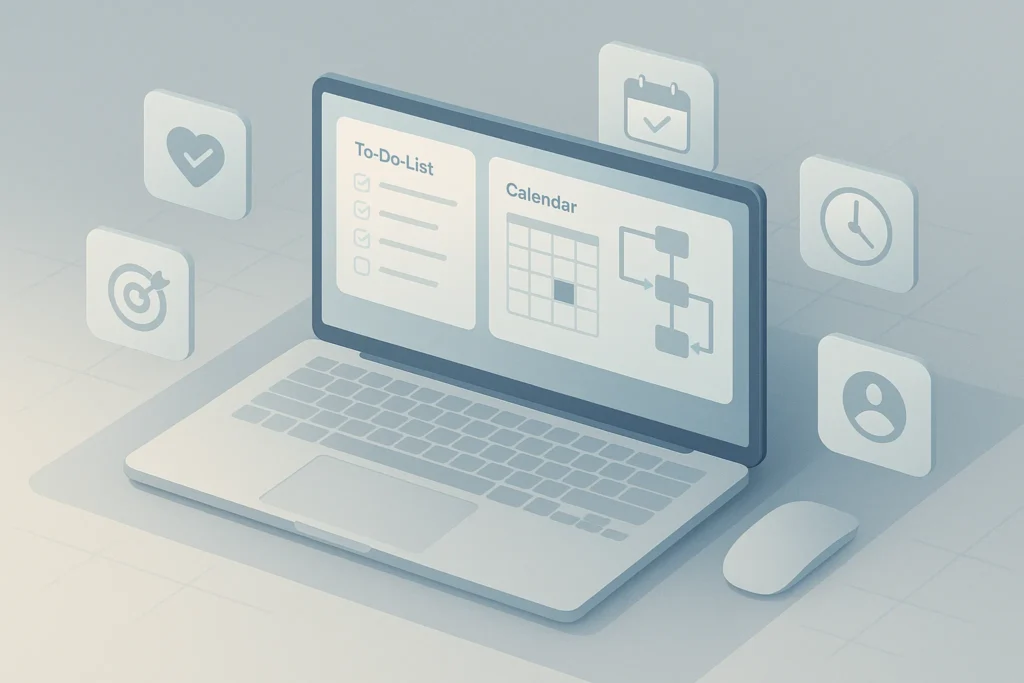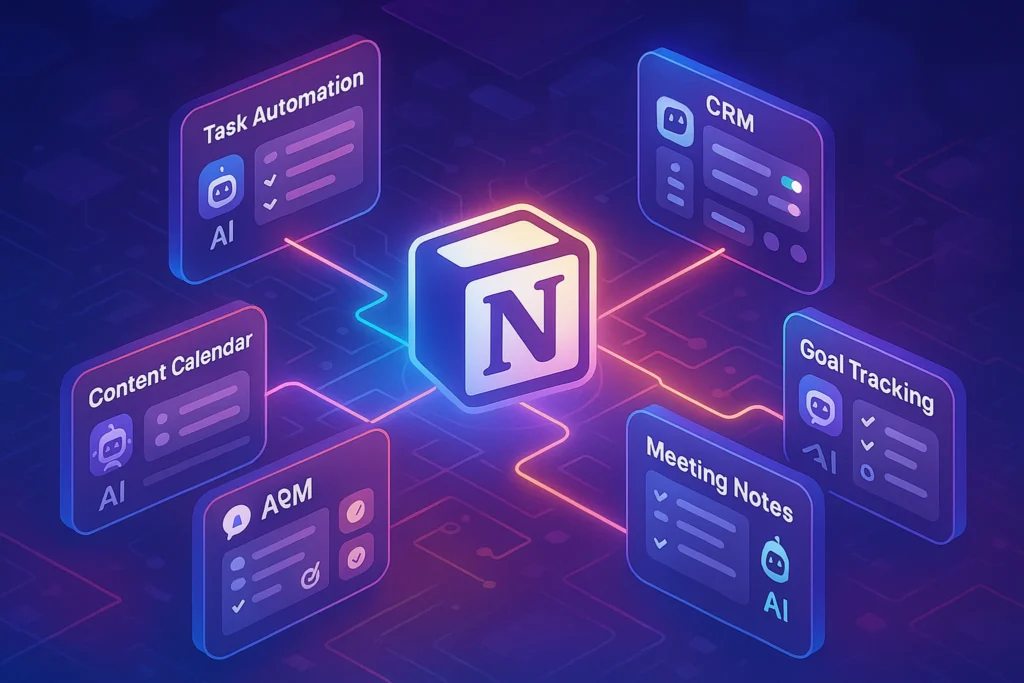-This post may contain affiliate links. If you click on one and make a purchase, I may earn a small commission at no extra cost to you.-
🌍 Introduction
Most productivity advice sounds great in theory — morning routines, to-do lists, deep work, time blocking — but somehow, your days still end in chaos.
The problem isn’t you. It’s the lack of a real system.
A productivity system isn’t just a planner or a list — it’s a repeatable structure that helps you decide what to do, when to do it, and how to stay focused. Without it, even the best intentions fall apart.
In this post, you’ll learn how to build a productivity system that actually works — one that’s simple, flexible, and fully tailored to how you think and work. Whether you’re a student, freelancer, or founder, this guide will help you:
-
Eliminate decision fatigue
-
Focus on what matters
-
Make consistent, meaningful progress
-
Integrate tools that work with your brain, not against it
Let’s break it down — step by step.
Step 1: Define What “Productivity” Means to You
Before diving into apps or habits, ask yourself: What does being productive look like in your life?
For some, it’s checking off 20 tasks. For others, it’s completing one meaningful project without burnout.
Write down:
-
What does a “productive day” feel like?
-
What types of tasks drain you vs. energize you?
-
Are you output-focused (deliverables) or process-focused (consistency)?
🧠 Tip: If you don’t define success, no system can help you achieve it.
Step 2: Identify Your Energy Rhythms and Time Patterns
Your productivity system should follow your biology — not fight it. Notice:
-
When do you feel most alert?
-
When does your energy dip?
-
Are you a sprinter (short bursts) or marathoner (long sessions)?
Based on this, you’ll build time blocks and routines that align with your natural flow. There’s no point planning your hardest task at 3PM if you’re mentally gone by then.
Want to go deeper? Check out 20 Windows 11 Keyboard Shortcuts That Will Seriously Boost Your Productivity — it’s full of tiny time-savers that make a big impact.
Step 3: Pick a Central Command Center (Digital or Physical)
You need one hub where everything lives: tasks, goals, ideas, notes, deadlines.
Popular digital options include:
-
Notion – for customizable dashboards
-
Todoist – for powerful task tracking
-
ClickUp – for all-in-one project management
-
Motion – for auto-scheduling tasks into your calendar
-
Sunsama – for combining daily planning with mindful focus
📌 Bonus: Sunsama and Motion offer AI-powered scheduling — check out our full comparison in Best Smart Calendar Apps for Productivity (+ AI Features)
Whichever tool you pick, commit to using just one. Fragmentation = mental friction.
Step 4: Design Your Weekly Workflow (Input → Focus → Output)
Build a Weekly Workflow Framework
Now let’s architect your weekly loop:
Monday Planning:
-
Review your goals
-
Break down projects into tasks
-
Time-block your week
Friday Review:
-
What worked?
-
What got delayed?
-
What do you want to change next week?
This rhythm creates momentum — and prevents the “where do I even start?” spiral.
The key to a productivity system that lasts isn’t rigidity — it’s rhythm. While many people start with unrealistic, over-scheduled routines, the truth is that a flexible weekly structure works better for long-term consistency.
Here’s how to build yours:
🗓 Weekly Planning (Sunday or Monday):
Set aside 20–30 minutes to review your calendar, projects, and personal goals. Break down big outcomes into specific, time-bound tasks. Use Notion, Sunsama, or a simple paper planner — the tool doesn’t matter as much as consistency.
🔥 Daily Focus:
Identify your “Top 3” tasks each day — ideally aligned with your weekly goals. Use calendar blocking or timeboxing techniques to dedicate focused blocks. For example, assign 90 minutes of deep work before checking emails.
-
Start with 1–3 high-priority tasks
-
Use a focus method (Pomodoro, Deep Work sprints)
-
End with a 5-minute review
📈 Weekly Review (Friday):
Spend 15–20 minutes reviewing what you accomplished, where you got stuck, and what you want to adjust. This reflection is what transforms a list into a system — and keeps you improving every week.
Step 5: Minimize Digital Distractions
Eliminate Distractions by Design
Distractions aren’t just annoying — they’re expensive. Every time you switch focus, your brain takes 15–25 minutes to fully return to the task at hand. Multiply that by dozens of interruptions a day and you’ve lost hours.
Here’s how to defend your system:
🧱 Create a “Focus Ritual” — e.g., closing all tabs, turning on Freedom, playing a specific playlist, turning phone face down. This conditions your brain to enter deep work mode.
💡 Set “Reactive Zones”: Only check email, Slack, or messages during 2–3 windows per day. Outside those times, close the tabs. This alone can 2x your focus.
🎯 Remember: Productivity is about protecting your attention as much as managing your time.
A system is only as good as your environment. Block distractions with purpose-built tools like:
-
Freedom – block websites and apps across all devices
-
Cold Turkey – schedule focus blocks
-
Forest – gamify your focus sessions with tree growth
These tools gently push you to stay within your own boundaries — no more “accidental scrolling.”
Step 6: Make It Visual (Your Brain Loves Clarity)
Make It Visual
Humans process visuals 60,000x faster than text. So if your productivity system is just a text list, you’re under-utilizing your brain.
Here’s how to make it visual:
🟢 Use a color key: Green for high-focus tasks, blue for meetings, red for deadlines.
📊 Build a progress dashboard in Notion or Trello.
📌 Use visuals like icons, emojis, and progress bars to gamify your day.
Visual clarity creates emotional clarity. When you can see your progress, you’re more likely to keep going.
Use visual cues to reinforce your system:
-
Color-code your calendar
-
Add icons or emojis to categories (📧 email, 📚 learning, 💬 meetings)
-
Build a weekly review template inside Notion or Google Docs
Visual structure reduces decision fatigue and increases follow-through.
Step 7: Sync Your System With Real Life
Design for Real Life
Real life is messy. Appointments get canceled. Kids get sick. Clients ghost. If your system expects a perfect day to work, it will fail.
Instead, build redundancy into your setup:
✅ Schedule only 70–80% of your time
✅ Batch small tasks into flexible “admin blocks”
✅ Always have a catch-up buffer on Fridays or Sunday nights
🧠 Flexible systems last longer than perfect ones.
No system survives first contact with reality unless it’s adaptable. Build in margins, blank space, and contingency buffers.
🧠 Nerd tip: If your system collapses after one missed day, it’s not a system — it’s a trap.
Start small. Iterate weekly. Add complexity only if you need it.
Step 8: Integrate Habit Tracking & Reflection
Add Habit & Reflection Loops
What makes a system sticky is reflection. By asking simple questions daily, you turn your workflow into a feedback loop that grows with you.
Try these daily prompts:
-
What did I finish today?
-
What drained my energy?
-
What gave me momentum?
Track habits weekly. Celebrate wins. And when you miss a day? Log it. No guilt — just data.
📱 Tools to try:
-
Loop Habit Tracker (Android)
-
Streaks (iOS)
-
Notion habit boards (template-based)
Finally, add a habit loop to reinforce your momentum:
-
Use apps like Streaks, Habitica, or Loop Habit Tracker
-
Keep a simple log of “What did I finish today?”
-
Celebrate small wins — progress is the goal, not perfection
🚫 Biggest Mistakes to Avoid When Building a Productivity System
-
Starting with tools instead of goals
→ Your system should serve your vision, not the other way around. -
Over-scheduling every hour
→ You’ll burn out in a week. Leave breathing room. -
Using 5 different apps at once
→ Pick one central hub and stick with it. -
Never reviewing your week
→ The weekly review is where insight + improvement happens. -
Trying to be perfect
→ A messy but consistent system always beats a flawless one you abandon in 3 days.
💼 Real-World Productivity Stack Example
Here’s a sample setup used by a freelance writer and solo founder:
-
Command Center: Notion (dashboard for goals, task board, and content calendar)
-
Task Execution: Motion (AI auto-scheduling of daily tasks)
-
Focus Support: Forest app + Spotify “Lo-fi” playlist
-
Weekly Planning: 30-minute Sunday review + daily Top 3
-
Distraction Blocker: Cold Turkey for 90-min deep work blocks
-
Habit Tracker: Streaks + a nightly “What worked?” journal entry
This system takes ~30 minutes/week to maintain, but saves 5+ hours of friction and indecision.
🧠 Nerd Verdict
Most productivity tools focus on speed. But the best systems focus on sustainability.
The system you build today doesn’t need to be perfect — it just needs to be real, repeatable, and yours. Start simple. Track your progress. Adapt weekly.
If you build a system that fits your life and your energy, productivity becomes effortless.
Productivity isn’t about doing more — it’s about building a system that frees your mind to do better. When your tasks, time, and attention are aligned with your values and rhythms, focus becomes natural.
You don’t need another app or fancy method — you need clarity, rhythm, and follow-through.
And remember: every productivity breakthrough starts with one small system you actually stick to.
❓ FAQ – Productivity System Setup
1. How is this different from just using a to-do list?
A productivity system includes routines, priorities, habits, and structure — not just tasks. It’s proactive, not reactive.
No. Many of the best tools like Notion, Google Calendar, and Todoist have free versions that are fully functional.
3. How long does it take to set up a working system?
Most people need 2–3 weeks to build and refine a sustainable system. Start small, test often, iterate weekly.
4. What’s the #1 mistake people make?
Trying to copy someone else’s setup. Your system should match your goals, energy, and working style — not someone else’s aesthetic dashboard.
5. What if I fall off track?
That’s normal. Systems are made to bend, not break. Just reboot with a review and start again. Consistency is built, not born.
💬 Would You Bite?
What part of your current workflow feels the most chaotic — planning, focus, or execution?
Let us know below. You might be surprised how many others feel the same 👇



